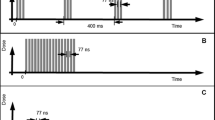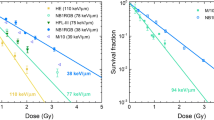Summary
Various equations describing survival curves for irradiated mammalian cells are discussed and the four-parameter multi-target equation with a single hit term has been chosen for the present analysis. This equation is closely related to the two-component theory which connects the lethal and sublethal (“potential lethal”) biological effects with high and low LET parts of the dose spectrum. Assuming an “energy package” (i.e. ionization energy contained in a small volume) of 750 eV the LET distribution and the absorbed dose distribution in a particle track can be calculated. Comparing the last values with results obtained from experimental survival curves, the lower limit for the high LET (α-component) is evaluated to be about 12 keV/µm givingα values of 0.16 and 0.45 for X-rays and 15 MeV neutrons respectively.
12 different cell lines taken from normal tissue and from various tumors irradiated aerobic in vitro with 300 keV X-rays and 15 MeV neutrons have been analysed and the parameters are displayed. The cell sensitivities show fairly great differences.
At the peak of the depth dose curve negative pion beams produce a composite radiation consisting of about\({\raise0.5ex\hbox{$\scriptstyle 2$}\kern-0.1em/\kern-0.15em\lower0.25ex\hbox{$\scriptstyle 3$}}\) high- and\({\raise0.5ex\hbox{$\scriptstyle 1$}\kern-0.1em/\kern-0.15em\lower0.25ex\hbox{$\scriptstyle 3$}}\) low LET radiation. Theα-value for the “pure star-dose” isα = 0.45. For the composite radiation the averageα-value will be about 0.34 to 0.29 depending on the relative momentum spread and the contamination of the beam with electrons and muons.
The LET spectrum of the star-dose is characterized by the proton component extending from about 1–50 keV/µm and theα-particle (and heavy recoils) component extending from about 20 to more than 200 keV/µm. The proton component will enhance theβ-effects, produced by LET radiations below 12 keV/µm. Theα-particle component having LET-values greater than 100 keV/µm will repress the oxygen influence on theα-effect to zero and thus lower the OER-value for pions to about 1.9 (OER ∼ 2.7 for low-LET radiation). RBE S = 0.1-values depend on cell parameters and might be about 1.6 or lower.
Up to the present time only a few cell-lines have been investigated. The measured survival curves are analysed and the evaluated cell parameters discussed.
Similar content being viewed by others
References
Barendsen, G. W.: Relative effectiveness of ionizing radiations in relation to LET and the influence of oxygen. Biophysical aspects of radiation quality. IAEA. Technical Report Series No. 58, p. 44 (1966)
Barendsen, G. W., Broerse, J. J.: Measurements of relative biological effectiveness and oxygen enhancements ratio of fast neutrons of different energies. IAEA. Biophysical aspects of radiation quality. Second Panel Report. Vienna, 1968 STI/PUB/171, p. 55
Broerse, J. J., van Oosterom, Pia M.: Response of mouse leukaemic cells after irradiation with X-rays and fast neutrons (IAEA-SM-179/8). Biological effects of Neutron Irradiation. Vienna, 1974 STI/PUB/352, p. 275
Broerse, J. J., Barendsen, G. W., Gaiser, J. F., Zoetelief, J.: The importance of differences in intrinsic cellular radio-sensitivity for the effectiveness of neutron radio-therapy treatments. IAEA-SM-212/31. Symposium in Vienna, Nov. 1976 (printing)
Green, A. E. S., Burki, J.: A note on survival curves with shoulders. Radiat. Res.60, 536–540 (1974)
Sinclair, W. K.: In: Biophysical aspects of radiation quality, p. 21. IAEA. Technical Reports Series No. 58, Vienna 1966
Leenhouts, H. P., Chadwick, K. H.: The RBE-LET relationship. 4th Symposium on microdosimetry, Verbania 1973. Commission of the European Communities. EUR 5122 d-e-f, pp. 381–403 (1974)
Wideröe, R.: Theories about radiobiological effects. Kerntechnik, Isotopentechnik und -chemie.19, 237 (1977)
Barendsen, G. W.: In the inital effects of ionizing radiations on cells, p. 183 (Harris, R. J. C., Ed.). London: Academic Press 1961
Bender, M. A., Gooch, P. C.: J. Rad. Biol.5, 133 (1962)
Wideröe, R.: Various examples from cellular kinetics showing how radiation quality can be analysed and calculated by the two-component theory of radiation. IAEA-SM-145/44 Vienna 1971, p. 311
Wideröe, R.: Cellular repair and recovery after radiation damage. 4th Symposium on Microdosimetry. Verbania 1973. EUR 5122 d-e-f, p. 405 (1974)
ICRU Report 16. Linear Energy Transfer. International Commission of Radiation Units and Measurements. June 1970, pp. 8–20
Wideröe, R.: Calculation of the number ofδ-electrons produced in water by high-energy electrons and X-rays. Atomkernenergie29, 62–66 (1977)
Howard-Flanders, P.: Physical and chemical mechanism in the injury of cells by ionizing radiations. Advan. biol. med. Phys.6, 533 (1958)
Cole, A., Cooper, W. G., Shonka, F., Corry, P. M., Humprey, R. M., Ansevin, A. T.: DNA scission in hamster cells and isolated nuclei studied by low-voltage electron beam irradiation. Radial. Res.60, 1 (1974)
Holt, P. D.: A calculation of the LET distribution from negative pi-mesons in tissue. Int. Congress on protection against accelerator and space radiation. Geneva, April 1971. CERN 71-16, p. 246
Guthrie, M. P., Alsmiller, R. G., Jr., Bertini, H. W.: Nucl. Instr. Meths.66, 29 (1968)
Dennis, J. A.: AERE-M2346 (1971)
Till, J. E., McCulloch, E. A.: Early repair processes in marrow-cells irradiated and proliferating in vivo. Radiat. Res.18, 96 (1963)
Rosen, L.: Possibilities and advantages of using negative pions in radiotherapy. Nucl. Appl.5, 379 (1968)
Blaser, J. P., Willax, H. A.: Proceedings of the IXth International Conference on High Energy Accelerators. Stanford Linear Acc. Center, May 1974, p. 643. See also: Haefeli, P.: Fortschr. Röntgenstr.121, 101 (1974)
Kaplan, H. S., Schwettman, H. A., Fairbank, W. M., Boyd, D., Bagshaw, M. A.: A hospital based superconducting accelerator facility for negative pi-meson beam radiotherapy. Radiology108, 159 (1973)
Richardson, J. R.: The status of TRIUMF. cnProceedings from the 7th International Conference on Cyclotrons and their Applications, p. 41. Basel-Stuttgart: Birkhäuser 1975
Perry, D. R., Hynes, M. A.: A pion beam for radiobiological and dosimetric studies, using a proton synchrotron external target. Proceedings Int. Congress on Protection against Accelerator and Space Radiation. Geneva, April 1971. CERN 71-16, p. 220
Fowler, J. F., Perkins, D. H.: The possibility of therapeutic applications of beams of negativeπ-mesons. Nature (Lond.)189, 524 (1961)
Fowler, J. F.:π-meson versus cancer? Proc. physical. Soc. (Lond.)85, 1051 (1965)
Bond, V. P.: Negative pions: Their possible use in radiotherapy. Amer. J. Roentgenol.111, 9 (1971)
Curtis, S. B., Raju, M. R.: A calculation of the physical characteristics of negative pion-beams energy-loss distribution and Bragg curves. Radiat. Res.34, 239 (1968)
Raju, M. R., Richmann, C.: Negative pion radiotherapy: Physical and radiobiological aspects. Curr. Top. Radiat. Res. Quarterly8, 159 (1972)
Baarli, J., Nordell, B., Sullivan, A. H., Zielczynski, M.: Determination of some parameters for pion radiobiology studies. Phys. Med. Biol.22, 466–475 (1977)
Dutrannois, J. R., Hamm, R. N., Turner, J. E., Wright, H. A.: Analysis of energy deposition in water around the site of capture of a negative pion by an oxygen or carbon nucleus. Phys. Med. Biol.17, 765 (1972)
Boyd, D. P.: High-Energy Physics Laboratory Reports No. 657 and TN-71-1. Stanford University, Stanford, Cal. 1971
Skarsgard, L. D., Henkelman, R. M., Lam, K. Y., Harrison, R. W., Palcic, B.: Physical and radiobiological properties of theπ-meson beam at TRIUMF. Proceedings International Symposium on Radiobiological Research needed for the Improvement of Radiotherapy. IAEA Vienna, Nov. 1976 (printing)
Mills, F. E., Cronkite, E., Bond, V. P., Friedlander, G.: Use of the Brookhaven National Laboratory alternating gradient synchrotron for pi-meson radiotherapy. Research Proposal to the National Institutes of Health. Brookhaven, Nat. Lab., July 1971
Thiessen, H. A.: A design study of aπ-beam for biomedical applications at LAMPF. Los Alamos Scientific Labor. Report LA-DC-9789 (1968)
Curtis, S. B.: An analysis of human kidney cell oxygen-enhancement ratios for fast neutron beams and a prediction for negative pion beams. Radiat. Res.46, 557 (1971)
Wideröe, R.: A discussion of the oxygen effect based upon the two-component theory of radiation. Radiol. clin. (Basel)39, 20 (1970)
Wideröe, R.: Remarks on oxygen effects. Rad. and Environm. Biophys.12, 233 (1975)
Chapman, J. D., Dugle, D. L., Reuvers, A. P., Gillespie, C. J., Borsa, J.: Chemical radiosensitization studies with mammalian cells growing in vitro. Proceedings of the 5th Int. Congress of Radiation Research. Seattle, July 1974, p. 752
Barendsen, G. W.: Mechanism of action of different ionizing radiations on the proliferative capacity of mammalian cells. Advances in theoret. and experiment. Biophysics, Vol. 1, p. 167 (Cole, A., Ed.). New York: Marcel Dekker 1966
Broerse, J. J.: Effects of energy dissipation by monoenergetic neutrons in mammalian cells and tissues. Thesis. Amsterdam 1966
Mill, A. J., Lewis, J. D., Hall, W. S.: Response of HeLa cells to irradiation withπ-mesons. Brit. J. Radiol.49, 166 (1976)
Fritz-Niggli, H., Blattmann, H., Michel, Chr., Rao, K. R., Schweizer, P.: Preclinical experiments withπ −-beam of the SIN: RBE-values of tumor and normal cell systems and genetic damages in peak and plateau. Proceedings Int. Symposium on Radiobiolog. Research needed for the Improvement of Radiotherapy. IAEA Vienna, Nov. 1976 (printing)
Author information
Authors and Affiliations
Rights and permissions
About this article
Cite this article
Wideröe, R. A comparison of radiation effects on mammalian cells in vitro caused by X-rays, high energy neutrons and negative pions. Radiat Environ Biophys 15, 57–75 (1978). https://doi.org/10.1007/BF01330900
Received:
Issue Date:
DOI: https://doi.org/10.1007/BF01330900




